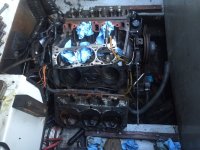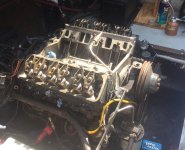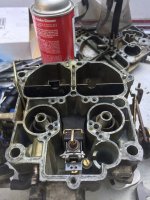Oil analysis .... It is NOT the proper tool to assess how well your engine is wearing.
At best, it merely provides a trend of what may be expected for your engine in your usage patterns, when compared over several samples of the same oil product. Measuring wear in an engine accurately costs WAY more than any oil analysis does.
UOAs most certainly can be used to see how an engine is wearing. The problem is that most people don't know how to properly apply the UOAs as a tool, and how to interpret the UOA data, and apply it to their application.
Here is the truth about UOAs:
- UOAs will not see all wear metals; they see a portion of wear metals, below 5um
- UOAs imply an overall wear metal concentration based on the % of wear they do see; (it's a representative "sample" of the whole environment, not unlike taking a sample of deer population to determine the overall population in a given area)
- UOAs can be done singularly to check for contamination concerns
- UOAs must be done consequtively to look for wear trends
- UOAs will tell you about the lube characteristics (however, there is absoutely no assurance one way or another that any given criteria is going to affect the wear rates ... i.e. the TBN or TBN/TAN crossover does not always affect wear rates)
- UOAs have been shown in SAE studies to have very good correlation between ICP determined wear rates and particulate loading (some of the "filter" studies)
- UOAs have been shown in SAE studies to have very good correlation between ICP determined wear rates determined with other methods like component weight analysis and electron bombardment analysis)
- UOAs can be hard to discern when changes occur versus normal variation of wear (small shifts in wear metals may be mis-interpreted by the viewer)
- UOAs can sometimes (but not always) discover wear trends when no other garage methods have reported the onset of a problem
Further, allow me to quote myself from another thread:
dnewton3 said:
Finding equipment problems is a function of how hard you look, how often you look, and what tools you look with. Using UOAs will not assure you that you'll discover a problem, but they are most certainly proven to improve the odds of finding a problem. Here's what we can do to find an equipment problem ...
- look for visual clues (leaks and other abnormalities)
- listen for audible clues (clunking, grinding, squeals, chirps and other abnormalities)
- feel for tangible clues (vibration)
- analyze with high-tech tools (thermal sensing guns, non-primary-order vibration sensors)
- do UOAs to track your unique equipment history and compare/constrast against known "good" examples (wear metal abnormalities)
- track fluid consumption (loss, or transfer of lube and coolant for example)
Some of these are outside the cost and skill levels of the average Joe. But some are easily done in the garage at home. UOAs are not the only means of finding "real damage"; they are but one of several. UOAs work well; not always, but often enough to make them one of the viable tools to find problems. UOAs also offer a distinct advantage in that they are objective and not subjetive. They are also relatively inexpensive relative to other costs such as uber-expensive high-tect tools or engine tear-downs. As you add "tools" to your analysis, you improve the likelihood that you'll discover problems as they develop. It's not that you can be 100% sure; it's much more akin to simply improving your odds of accuracy. UOAs are not going to be without error at all times, but they are also not 100% worthless either. At times, they will be the lead indicator, other times not. That is true of all those "tools" above.
There are other means of measuring wear:
-
physical component measuring: you have to tear the engine down, which is stupidly time consuming and introduces two other concerns. First, the gauge R&R of hand measuring tools is often poor. Second, and this is a big problem ... reassembly introducts all manner of "new" variable such as torque values, exact placement of bearing journal inserts, unforseen scratches and damage ... This "tear down" method is a fools errand for measuring wear. No normal person has the time and money to do an engine teardown every year to see how his/her equipment is wearing
-
component weight analysis: again, to get to the wear parts (cams, crank, pistons/cylinders and associate bearings) you have to tear the engine down. While there are hyper-acurate scales which can measure the weight changes of these components, not one Joe Average is going to have the money to purhcase one of these scales, AND you still won't have the time/money to do an engine tear-down annually in your garage
-
electron bombardment analysis: pretty much the same issues as the others ... super expensive equipment that one normal person can afford, and you're still into tearing an engine down with all it's own problems of induced errors upon reassembly
The thing to understand is that there's only two ways to measure wear; direct and indirect.
Direct methods all are fraught with high costs, massive time investments, and induce secondary concers upon reassembly.
Indirect methods (UOAs) are not fool-proof, but are proven reasonably accurate via good correlation to the other methods, and have the added benefits that they are quickly done with no intrusion into the engine, and they are low cost relative to any other means of assessing wear.
The other topics to understand are those of time duration, and quantity of problems.
Time duration is a sense of how much wear is occurring relative to the sample frequency. A "catastrophic" event can be chronic (timing chain eating away at the cover) or accute (con-rod snaps and ventilates the block with a large breathing hole). Quantification of the issue is a matter of understanding if the wear is "normal" or "abnormal". Some engines shed a lot more metals than others, and yet still live reasonably long service lives. Older engine designs combined with older manufacturing processes (the old SBC, for example) make for engines which shed a lot of Fe, but that doesn't stop them from running a long time; they just get "looser" a lot "quicker" than modern engine designs.
Are UOAs a perfect means of mearusing wear? No.
Are UOAs the best "at home" means to infer wear? Yes.
Are UOAs often misinterpreted by most people? Without any doubt, Yes.
Just because UOAs are a misunderstood sampling tool, does not mean the tool is bad or untrustworthy. Don't blame the tool for the errors of the user.
.




